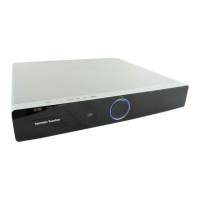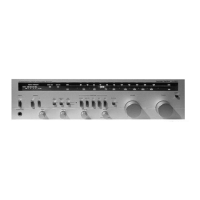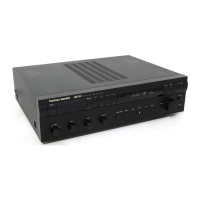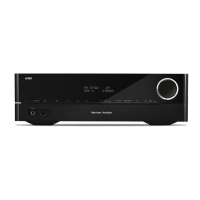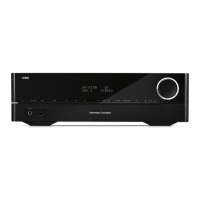When
in this position
the
separation
between
LEFT
and
RIGHT
will
be
partially
reduced
from
that
obtained
in
the
normal
SQ
MATRIX
1 position
and
the
separation
between
FRONT
and
BACK
will
be
slightly
increased.
When
reproducing
full
orchestral material,
the
mode
selector should
be
in
the
SQ MATRIX 1 position.
When
reproducing
individual instruments
or
soloists
the
mode
selector
switch should
be
in
the
SQ MATRIX 2 position.
ENHANCED
STEREO
This position should
be
used
to
enhance
(convert)
any
stereo
source
into
spatially
expanded
sound.
When
playing
any
stereo
source, if your
100
+
has
been
installed utilizing four
or
eight
speakers,
the
sound
will
emerge
from
each
speaker
filling
the
room with sound
that
is
almost
as
exciting
as
authentic
4-CH.
It
may also
be
used
to
spatially
enhance
a
monophonic
source.
In
this position
the
~
D
mode
indicator
lights
will
be
illuminated,
noting
stereo
to
4-CH
operation.
4-CH
DISCRETE
In
order
to utilize this position you
MUST
have
a four
channel
source con-
nected
to
the
system.
In
this position D
II
mode
indicator
lights will
be
illuminated
denoting
4-CH to 4-CH
operation.
VOLUME
CONTROL
THE
VOLUME
control adjusts
the
signal
level
of
any
program
material
connected
to your receiver.
It
is
a four section control which simultaneously
adjusts all
channels,
and
its close tracking specifications insure
that
the
relative
volume level
of
each
channel
will
be
identical.
SOUND
FIELD
BALANCE
Your
100
+
incorporates
a unique four
channel
continuously
variable
balance
control.
The
nature
of
stereo
or
4-CH reproduction
is
such
that
it
requires identical
channels
to
attain
the
highest
degree
of
faithfulness
and
spatial
distribution.
Any variation
in
the
efficiency
of
any
channel
as
compared
to
the
others
will
disturb this relationship. Since
there
may
be
slight
differences
between
program
material, room acoustics, etc., your receiver includes a control to
balance
all
channels.
Sufficient
range
is
covered
by
this control to permit
rebalancing
of
the
overall system even
in
cases
where
major
unbalance
exists.
This
control
may
be
set
anywhere
within its
range
to
attain
system
balance.
It
does
not
necessarily
have
to
be
set
in
the
exact
center
position.
When
the
BALANCE
control
is
properly
set,
the
apparent
sound source
will lie
in
a
broad
area
between
all
speakers.
8
LEFT
a RIGHT
FRONT
SPEAKER BALANCING
LF
(BACK SPEAKERS
OFF)
RF
Ci] •
[iJ
LEFT~~~~~:
~XO:~ti~~-
(RIGHT FRONT a BACK SPEAKERS OFF)
..._
RIGHT FRONT a
RIGHT
BACK
..,,
SPEAKER BALANCING
(LEFT FRONT a BACK SPEAKERS OFF)
~
LB
TUNING
LEFT
a RIGHT BACK
SPEAKER BALANCING
(FRONT SPEAKERS
OFF)
The tuning knob,
located
on
the
right
side
of
the
receiver
is
used
to
select
the
desired
station
when
your FUNCTION switch
is
in
the
FM,
STEREO
FM,
or
AM
position.
SELECTING
MONOPHONIC
OR
FM
STEREO
BROADCAST
Under
normal use for all
FM
broadcasts
the
function selector switch should
be
placed
in
the
STEREO
FM
position.
Your receiver
is
equipped
with a
stereo
sensing circuit which will auto-
matically
determine
whether
your unit
is
receiving monophonic
or
stereophonic
broadcasts,
and
then automatically
adjust
the
mode
of
operation.
If
the
station
is
transmitting
stereo,
your receiver will automatically switch
on
the
multiplex section
and
you will
hear
the
broadcast
in
full
stereo.
Should
the
station
conclude
broadcasting
in
stereo,
your receiver
will
automatically
switch
back
to monophonic reception.
Should you receive a
weak
stereo
signal
whose
quality
has
been
degraded
by
noise
or
poor
signal conditions,
and
you wish to listen to this
stereo
broad-
cast
monophonically,
place
the
function selector switch
in
the
FM
position.
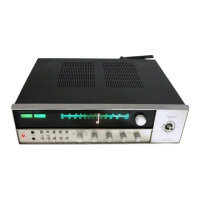
